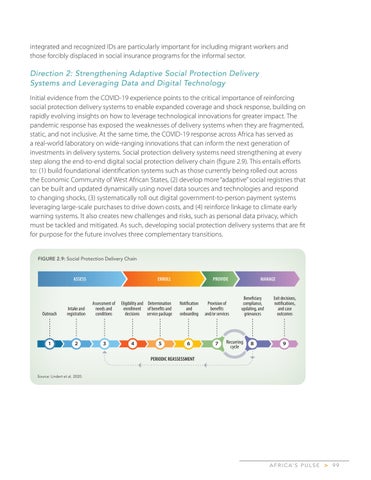integrated and recognized IDs are particularly important for including migrant workers and those forcibly displaced in social insurance programs for the informal sector.
Direction 2: Strengthening Adaptive Social Protection Delivery Systems and Leveraging Data and Digital Technology Initial evidence from the COVID-19 experience points to the critical importance of reinforcing social protection delivery systems to enable expanded coverage and shock response, building on rapidly evolving insights on how to leverage technological innovations for greater impact. The pandemic response has exposed the weaknesses of delivery systems when they are fragmented, static, and not inclusive. At the same time, the COVID-19 response across Africa has served as a real-world laboratory on wide-ranging innovations that can inform the next generation of investments in delivery systems. Social protection delivery systems need strengthening at every step along the end-to-end digital social protection delivery chain (figure 2.9). This entails efforts to: (1) build foundational identification systems such as those currently being rolled out across the Economic Community of West African States, (2) develop more “adaptive” social registries that can be built and updated dynamically using novel data sources and technologies and respond to changing shocks, (3) systematically roll out digital government-to-person payment systems leveraging large-scale purchases to drive down costs, and (4) reinforce linkage to climate early warning systems. It also creates new challenges and risks, such as personal data privacy, which must be tackled and mitigated. As such, developing social protection delivery systems that are fit for purpose for the future involves three complementary transitions.
FIGURE 2.9: Social Protection Delivery Chain
ASSESS
ENROLL
Outreach
Intake and registration
Assessment of needs and conditions
1
2
3
Eligibility and Determination enrollment of benefits and decisions service package
4
5
PROVIDE
Notification and onboarding
Provision of benefits and/or services
6
7
MANAGE Beneficiary compliance, updating, and grievances
Recurring cycle
8
Exit decisions, notifications, and case outcomes
9
PERIODIC REASSESSMENT Source: Lindert et al. 2020.
A F R I C A’ S P U L S E
>
99

